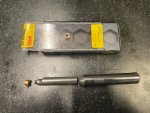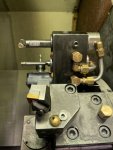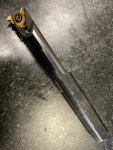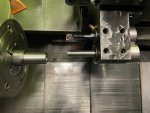Spruewell
Well-known member
- Joined
- Mar 6, 2021
- Messages
- 674
- Reaction score
- 441
I’m running a job doing a pair of bushings in 12L14 with an internal thread (M20x2.5 and M24x3.0). A rather tight bore and coarse pitch. I was planning on running both parts with the same bar and insert to save some tooling and setup cost. I ended up getting a Sandvik Corocut MB bar and inserts. Nice looking little solid carbide, through coolant bar that was the perfect length to reach the 2” thread depth I needed.
Got the job all set up and started making first articles while dialing in feeds and speeds. As I was fine tuning the threads, I noticed that the adjustments I was making were not holding stable.. the screw holding the insert on the end of the bar had loose up. No problem, torque that thing down a little better and off I go. About 250 parts later, I’m getting smooth bore bushings. The bar snapped off. Ok, order another.
Tool shows up and is installed today. I run a first article, everything looks good. Off to the races! 5 parts later and something doesn’t sound right.



Anyone have a similar experience with these? Am I missing something? At this point I’m going to have to make something else work as I have just about exceeded the budget on this project (them little suckers are pricey)
almost forgot to mention I had it running about 625rpm to keep the chatter down. Started out with .01” doc, then about halfway down backed off to .005” doc with a spring pass at the end.
Got the job all set up and started making first articles while dialing in feeds and speeds. As I was fine tuning the threads, I noticed that the adjustments I was making were not holding stable.. the screw holding the insert on the end of the bar had loose up. No problem, torque that thing down a little better and off I go. About 250 parts later, I’m getting smooth bore bushings. The bar snapped off. Ok, order another.
Tool shows up and is installed today. I run a first article, everything looks good. Off to the races! 5 parts later and something doesn’t sound right.



Anyone have a similar experience with these? Am I missing something? At this point I’m going to have to make something else work as I have just about exceeded the budget on this project (them little suckers are pricey)
almost forgot to mention I had it running about 625rpm to keep the chatter down. Started out with .01” doc, then about halfway down backed off to .005” doc with a spring pass at the end.
Last edited:


